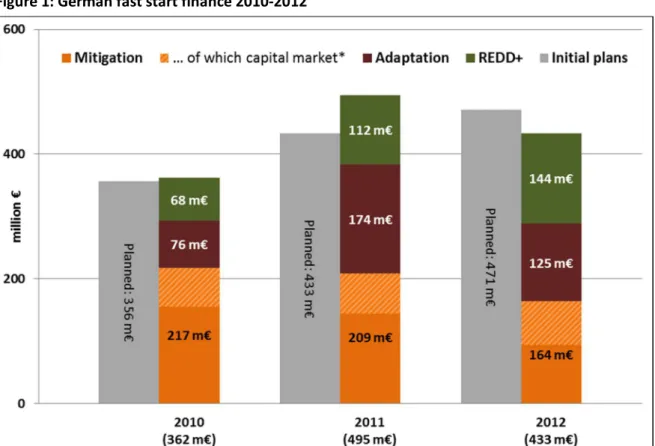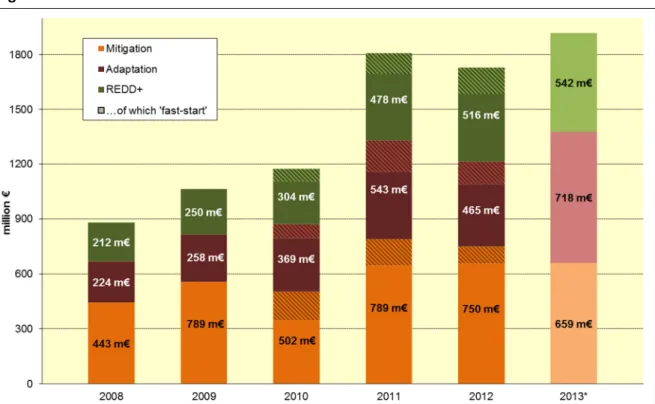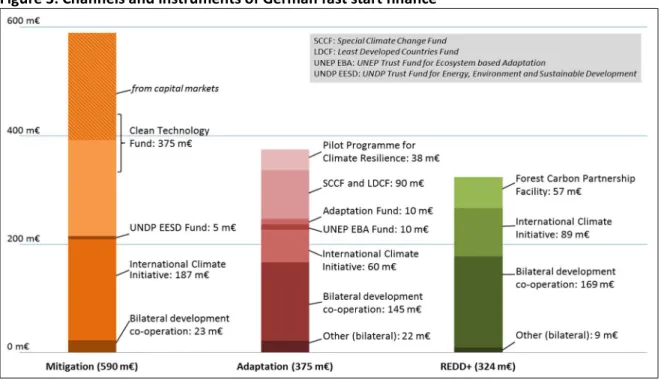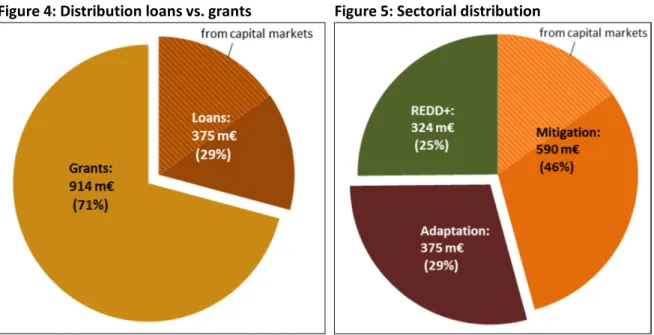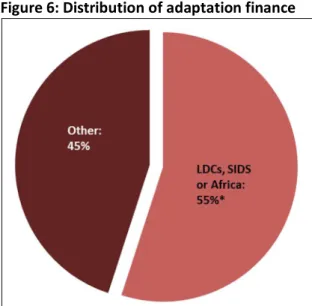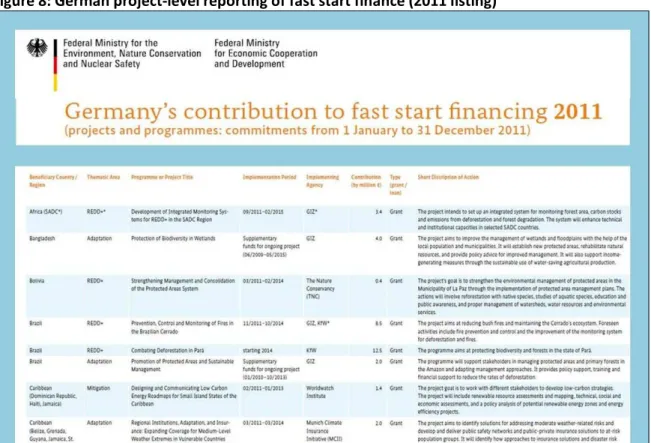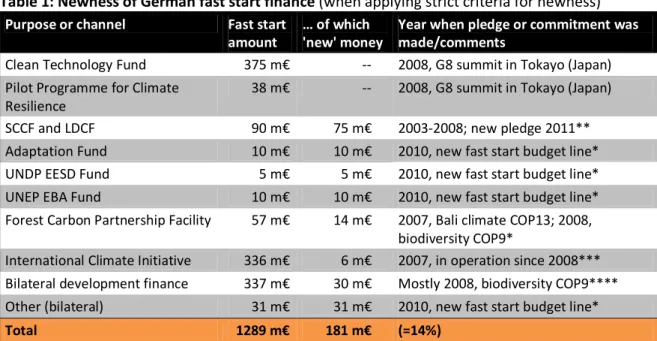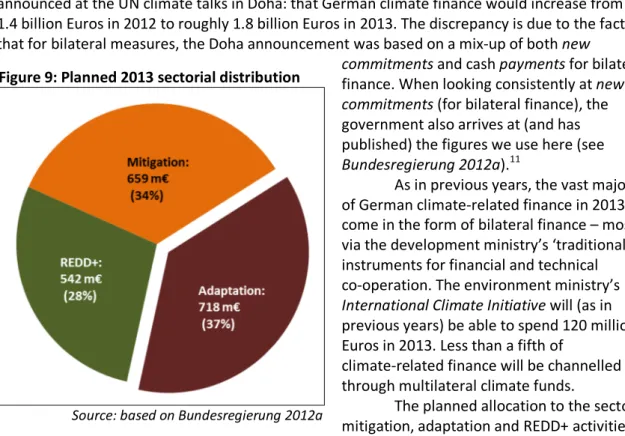Oxfam Germany Brief – April 2013
Promising the moon or delivering down-to-earth?
An overview of German fast start finance 2010-2012
At the 2009 Copenhagen UN climate summit developed countries had pledged to support developing countries’ efforts to reduce emissions and adapt to a changing climate with new and additional 30 billion US-Dollars as ‘fast start finance’ over the years 2010-2012. This constituted an important step towards the longer-term goal of developed countries to mobilise climate finance to increase to 100 billion US-Dollars per year by 2020. The fast start period has now ended. At face value, developed countries have met and even exceeded their pledge. When looking at fast start finance in more detail, it turns out that most of the money had already been planned, budgeted or otherwise been in the pipeline before the Copenhagen summit, hence was neither new nor additional; only a fifth was provided for adaptation; less than a quarter was channelled through multilateral climate funds; and more than 40 per cent came in the form of loans, capital contributions or similar instruments, instead of public finance grants.1
Germany had pledged to contribute 1.26 billion Euros and has even (slightly) exceeded this pledge if looked at it at face value. However, very little of Germany’s fast start finance was genuinely ‘new’ money, none of it was additional (if applying strict criteria, see also page 6);
Germany provided less than a third of fast start finance for adaptation. There was a relatively balanced use of multilateral and bilateral funding channels. German fast start finance included one loan and was provided mostly in the form of public finance grants.
Figure 1: German fast start finance 2010-2012
* The striped areas show the proportion of German fast start finance that was sourced from the capital market, leveraged with finance from the federal budget to create a loan package to the World Bank’s Clean Technology Fund (see footnote 6 for further explanations).
Source: based on Bundesregierung 2012c and 2013
1 See Oxfam 2012b
Figure 1 above shows annual fast start finance amounts for mitigation (orange and striped area), adaptation (red-brown area) and REDD+2 activities (green area). Note that we separate funds provided through the federal budget from funds mobilised on the capital markets (as part of a loan package to the World Bank’s Clean Technology Fund, see below and footnote 6). The latter is indicated by the striped areas. Non-striped areas are genuine contributions from the German federal budget.
Fast start finance within overall climate-related (development) finance
German climate-related financial support to developing countries goes well beyond what Germany has provided as fast start finance. Over the years 2010-2012, fast start finance
constituted about a quarter of overall climate-related finance during the same period.
Climate-related finance has been growing over the past years. While such an increase is certainly welcome, the real climate-relevance of at least some of the spending officially labelled ‘climate finance’ may often be lower than officially suggested.3 Also, the rise of German climate-related finance took place within largely non-rising overall development finance levels. That climate finance is not provided in addition to development finance targets is a growing problem, as in particular first draft figures for the 2014 federal budget suggest (see page 8).
Figure 2: German climate-related finance 2008-2013
* The 2013 figures are very likely to be adjusted downwards as they are based on government plans from autumn 2012.
About 480 million Euros of the 2013 total were meant to be sourced from auctioning revenues under the EU emission trading scheme. Given the dramatic decrease of the price for CO2 allowances, figures are likely to change. See page 8.
Source: based on Bundesregierung 2012a and 2013 Figure 2 shows climate-related flows over 2008-2013 for both bilateral and multilateral channels. The chart combines finance provided via the budgets of the development ministry, the environment ministry and a newly established special energy and climate fund (Sondervermögen
“Energie- und Klimafonds”, EKF). This fund has been set up to finance measures in the context of
2 REDD+ stands for Reducing Emissions from Deforestation and Forest Degradation. The “+” usually stands for the inclusion of measures such as better forest management, conservation, restoration, and afforestation.
3 In a 2012 assessment, Germanwatch found that donor-countries significantly overstated the adaptation relevance of development finance spending when coding projects with the (newly established) Rio Marker for adaptation. See Germanwatch 2012.
the German Energiewende (energy transformation) and is receiving nearly all of the German revenues from auctioning CO2 allowances under the EU emissions trading scheme. The EKF also has a spending title for international climate finance.4
For multilateral financing, the chart includes payments made to multilateral climate funds in a given year. For bilateral financing, the chart is based on bilateral commitments made to partner countries in a year (with actual payments happening during the implementation period of financed projects). The remarkable jump in climate-related finance shown for 2011 was mainly the result of a first set of such bilateral commitments from the international budget line of the above-mentioned EKF in that year. While actual ETS auctioning revenues are flowing into the fund only since 2012, the fund’s 2011 spending plan included forward budget authorisations that allowed making such commitments already in that year, based on expected future revenues. The 2011 jump in commitments will be mirrored by a jump in payments in 2013, when cash outflows are due following the 2011 (and 2012) commitments. See also page 8 for a 2013 outlook.
German fast start finance figures in detail
Figure 3 shows the bilateral channels or initiatives as well as the multilateral funds that were used for German fast start finance disbursement. The bottom two areas of the mitigation bar and the bottom three areas of the adaptation and the REDD+ bars are the bilateral channels, the remaining ones show finance for multilateral climate funds. The total volumes of many of the instruments or budget lines shown in the chart have been higher than the figures indicate, since only a proportion of the total amounts committed or disbursed during 2010-2012 have been considered ‘fast start’ by the government (following its definition of ‘new and additional’, see also page 6).5 It should also be noted (and applauded) that Germany did not count finance related to its export credit agency as fast start, nor any other official flows; nor was private finance counted.
Figure 3: Channels and instruments of German fast start finance
Source: based on Bundesregierung 2010, 2011b, 2012b and 2013
4 According to the EKF spending plan, about two thirds of its total resources are meant to be spent on activities to reduce domestic emissions, increase energy efficiency and promote renewable energies as well as on international climate finance. The remaining third is unfortunately reserved for measures that are counterproductive or climate-neutral, such as subsidising energy intensive industries or new coal, and for promoting e-mobility.
5 For instance, the Pilot Programme for Climate Resilience has received 50 million Euros, but only 38 million Euros are counted as fast start finance. Similarly, only a small part of climate-related financial and technical assistance via the development ministry’s budget gets counted as fast start finance.
The majority of German bilateral fast start finance has been realised as ‘traditional’
financial and technical co-operation via the development ministry, much of which has been (or will be) implemented by the German Agency for International Co-operation (GIZ) and the German development bank Kreditanstalt für Wiederaufbau (KfW). The other central bilateral channel is the International Climate Initiative (ICI) of the German environment ministry that provides on average 120 million Euros per year in bilateral climate finance. Originally, 110 million Euros a year from this initiative were to be counted as fast start finance during 2010-2012. Final figures now suggest these plans have been over-achieved by a small amount. Generally, the initiative’s funded activities will have had a more exclusive climate focus than e.g. activities funded by the
development ministry, although also the latter will still have had ‘climate-relevance’.
Figure 4: Distribution loans vs. grants
Source: based on Bundesregierung 2013
Figure 5: Sectorial distribution
Source: based on Bundesregierung 2013 German fast start finance included one loan – to the World Bank’s Clean Technology Fund (CTF). The loan has a total volume of 500 million Euros over the years 2010-2013. Of this amount, 375 million Euros are falling into the fast start period 2010-2012 and are counted accordingly (see Figure 4). Half of the amount was provided from the federal budget to the KfW, which used it to leverage the other half from the capital markets, in order to form a concessional loan to the CTF that in turn has been lending the finance to recipient countries.6
Figure 5 shows the distribution between adaptation, mitigation and REDD+ activities. The German government had aimed at allocating at least a third of total fast start finance to
adaptation, a goal that was missed by a small margin. This is mirrored also in overall
climate-related finance (i.e. fast start finance and other climate-related finance), where the share for adaptation has been even smaller than for fast start finance alone (see also Oxfam 2012a).
German climate finance is a long way from the balanced allocation between mitigation and adaptation that governments have agreed to reach. This means that too few investments are made in areas such as securing food security or reducing water scarcity – with dire consequences for vulnerable people in poor countries that contributed little or nothing to climate change.
On a positive note (Figure 6), more than half of fast start finance allocated to adaptation went to Least Developed Countries (LDCs), Small Island Developing States (SIDS) or countries in Africa. While many developing countries are highly vulnerable to climate change and in urgent
6 In Figure 1 on page 1, the capital market contribution (striped areas) is shown as spread over the three years. The KfW had, presumably with own capital, leveraged the loan for the CTF already in 2010, but the transfers from the federal budget to the KfW have happened subsequently over 2010-2012, and in each of the years the government reports a total loan contribution of 125 m€ to the CTF as fast start, combining funds from the capital markets with funds from the federal budget. By showing finance leveraged from the capital markets as spread over three years we follow the government’s accounting approach.
need of support for adaptation, the fast start finance pledge from Copenhagen included a prioritisation of these three country groupings when allocating adaptation finance.
Figure 7 shows the distribution of German fast start finance between finance for multilateral climate funds and bilateral activi- ties. The distribution appears quite balanced if the loan to the CTF is counted at face value.
When looking only at genuine contributions from the German federal budget (i.e. leaving aside leveraged finance), the share of
multilateral funding drops significantly. Also in overall German climate finance (i.e. fast start finance and other climate-related finance) over the years 2010-2012, the ratio is heavily tilted towards bilateral channels, with a mere 11 per cent having been channelled via multilateral climate funds.
Some positive observations can be made on the selection of multilateral funds:
Germany has provided significant amounts to the Special Climate Change Fund (SCCF) and the Least Developed Countries Fund (LDCF). Especially the engagement in the latter (totalling 165 million Euros, from five pledges since 2003) is a welcome development since that fund has been suffering from lack of finance for years, despite its much-needed function to finance the most urgent adaptation needs in the Least Developed Countries that are highly vulnerable to the impacts of climate change. Total German commitment to the SCCF stands at about 90 million Euros, from six pledges since 2004.
Figure 7: Distribution between bilateral activities and multilateral climate funds
Source: based on Bundesregierung 2010, 2011b, 2012b and 2013 Another very positive development is the German contribution to the Kyoto Protocol’s Adaptation Fund with its innovative approach of allowing developing countries direct access to finance via accredited National Implementing Entities (NIE). While Germany pledged only
10 million Euros (Spain contributed 45 million Euros), the mere occurrence of such a contribution to the fund is an important signal. Until then, the fund had been fed exclusively by a two per cent levy on carbon credits issued under the Clean Development Mechanism. This has left the fund severely underfunded so that funding disbursement had to be restricted despite a growing
Figure 6: Distribution of adaptation finance
*Based on data for bilateral activities until 15 September 2012. For multilateral climate funds we applied the share of finance committed so far to LDCs, SIDS or African countries from these funds to the German contributions to these funds.
Source: Bundesregierung 2010, 2011b and 2012b
number of incoming funding applications. Direct contributions from countries like Germany during the fast start finance period could not do away with the situation but certainly helped alleviating the problem to some degree. It now remains to be seen if developed countries continue to directly contribute to the Adaptation Fund.Currently, Germany has no such plans, despite hosting the fund (in the city of Bonn), a situation that one would expect leads to a special German interest that the fund is equipped with sufficient amounts of finance.7
Transparency in the reporting
No provisions for coherent monitoring, reporting and verification of fast start finance had been adopted alongside the fast start finance pledge. Germany published annual listings of bilaterally financed actions and contributions to multilateral climate funds (see Bundesregierung 2010, 2011b and 2012b), showing recipient country, sector, project description, financial
instrument, project duration and amount of support (Figure 8). The European Union followed the same approach and so did several other developed countries. This level of detail and clarity on the use of German fast start finance has been welcomed as a significant step forward.8
Figure 8: German project-level reporting of fast start finance (2011 listing)
Source: Bundesregierung 2011b
Old wine in ‘new and additional’ skins?
Developed countries had promised that fast start finance was to be ‘new and additional’
but failed to agree a common definition for that criterion, leaving its interpretation to individual countries. The German government considers its fast start finance ‘new and additional’ on grounds that it either constitutes an increase over 2009 climate finance levels or stems from
7 Recently, the Adaptation Fund board responded to the dire financial situation by issuing a fundraising goal of 100 million US-Dollars that so far has not been taken up by developed countries.
8 However, the climate finance reporting format that was adopted at the climate conference COP18 in Doha does not oblige countries to report on project level detail (i.e. listings of financed actions) but merely encourages doing so.
Disappointingly, Germany was among the countries that actively blocked developing countries’ demands in Doha to make Germany’s own good practice from fast start finance reporting obligatory to everyone for future climate finance.
innovative sources (as is the case of the International Climate Initiative that has been politically linked to revenues from auctioning carbon allowances under the EU emission trading scheme)9. It is no surprise that, by that two-tier definition, German fast start finance is entirely ‘new and additional’, because back in 2009, the size of the German fast start finance pledge had been defined by adding up those (already planned) funding lines and earlier announcements that would match these two criteria. To be fair, Germany did bother to find a definition and followed it through. Many other countries have used no reasonable definition of ‘new and additional’ at all.
Table 1: Newness of German fast start finance (when applying strict criteria for newness) Purpose or channel Fast start
amount
… of which 'new' money
Year when pledge or commitment was made/comments
Clean Technology Fund 375 m€ -- 2008, G8 summit in Tokayo (Japan) Pilot Programme for Climate
Resilience
38 m€ -- 2008, G8 summit in Tokayo (Japan)
SCCF and LDCF 90 m€ 75 m€ 2003-2008; new pledge 2011**
Adaptation Fund 10 m€ 10 m€ 2010, new fast start budget line*
UNDP EESD Fund 5 m€ 5 m€ 2010, new fast start budget line*
UNEP EBA Fund 10 m€ 10 m€ 2010, new fast start budget line*
Forest Carbon Partnership Facility 57 m€ 14 m€ 2007, Bali climate COP13; 2008, biodiversity COP9*
International Climate Initiative 336 m€ 6 m€ 2007, in operation since 2008***
Bilateral development finance 337 m€ 30 m€ Mostly 2008, biodiversity COP9****
Other (bilateral) 31 m€ 31 m€ 2010, new fast start budget line*
Total 1289 m€ 181 m€ (=14%)
* The 10 m€ to the Adaptation Fund, new pledges of 14 m€ to the Forest Carbon Partnership Facility, the contributions to the UNEP Trust Fund for Ecosystem-Based Adaptation and the UNDP Trust Fund for Energy, Environment and Sustainable Development, as well what is summarised as ‘Other (bilateral)’ were financed from two post-Copenhagen one-off budget lines with a total volume of 70 m€. We consider these amounts as genuinely new money.
** Of the 90 m€ fast start finance for the SCCF and LDCF, 15 m€ are covering pledges from before Copenhagen. The remaining 75 m€, however, are contributions from pledges after 2009, i.e. constitute genuinely new money.
*** The ICI budget line has been in place since 2008. Originally, 110 m€ of the ICI’s annual total of 120 m€ was to go to developing countries as fast start finance. The 6 m€ we label as ‘new’ money represents the over-fulfilment of the old (pre-Copenhagen) plans.
**** Most of the bilateral (climate-relevant) development finance is finance that is also provided to meet the German biodiversity pledge made at the biodiversity summit COP9 in 2008 (to provide 500 m€ in new finance until 2012 for the protection of global biodiversity, ecosystems and forests). Since this finance serves another pledge made elsewhere and also before Copenhagen, we consider it not to be ‘fresh’ money.
Source: Oxfam 2013 Table 1 shows newness of German fast start finance when applying a more ambitious definition for ‘new’, by which funds are labelled as ‘new’ only to the degree that they were provided not only above a 2009 baseline but also had not been pledged, committed, planned or otherwise been in the pipeline before the Copenhagen summit. By that definition, about 14 per cent of German fast start finance would receive the label ‘new’, as it would for instance rule out much of German fast start finance for REDD+ activities, for which finance is also counted towards meeting the German biodiversity pledge, made at the UN biodiversity conference COP8 in 2009, to provide 500 million Euros in additional support until 2012 for the protection of biodiversity and the world’s forests. Many other budget lines in German fast start were also rooted in plans or pledges from before Copenhagen (such as the pledge to the World Bank’s Clean Technology Fund,
9 Initially, this earmarking of (some of the) ETS auctioning revenues for the International Climate Initiative (ICI) was backed up with budgetary provisions. In 2009 these provisions were removed, giving the earmarking a political (and no more legal) nature. This has now changed again. Since 2012, nearly all of German ETS auctioning revenues flow into the special energy and climate fund Sondervermögen “Energie- und Klimafonds” (EKF) that also has a budget line for international climate finance.
or the International Climate Initiative that has been in place since 2008). A notable exception are two dedicated fast start budget lines, one in the development ministry, one in the environment ministry, of 35 million Euros each, that were newly established in the German federal budget in 2010, i.e. after the Copenhagen summit when the pledge was made.
If ‘additional’ was to mean finance that developed countries provide on top of their existing development finance commitments (to provide 0.7 per cent of their GNI as official
development assistance), then none of German fast start finance would be additional, as Germany counts all of its climate finance towards its ODA commitment. This creates an increasing
competition between climate and other development-related needs and ignores that climate change is an additional burden to developing countries.10
German climate finance in 2013 – impacts of the low carbon price
The bar on the far right in Figure 2 (page 2) shows official plans for climate-related finance from Germany for the year 2013. The bar indicates a volume of above 1.9 billion Euros, up from about 1.7 billion Euros in 2012. This seems to be (but isn’t) at odds with what Germany had announced at the UN climate talks in Doha: that German climate finance would increase from 1.4 billion Euros in 2012 to roughly 1.8 billion Euros in 2013. The discrepancy is due to the fact that for bilateral measures, the Doha announcement was based on a mix-up of both new
commitments and cash payments for bilateral finance. When looking consistently at new commitments (for bilateral finance), the government also arrives at (and has published) the figures we use here (see Bundesregierung 2012a).11
As in previous years, the vast majority of German climate-related finance in 2013 will come in the form of bilateral finance – mostly via the development ministry’s ‘traditional’
instruments for financial and technical co-operation. The environment ministry’s International Climate Initiative will (as in previous years) be able to spend 120 million Euros in 2013. Less than a fifth of
climate-related finance will be channelled through multilateral climate funds.
The planned allocation to the sectors mitigation, adaptation and REDD+ activities is shown in Figure 9.12 For the first time, at least according to plans, adaptation could receive the largest share of the three sectors. Yet, Germany remains far away from a balanced allocation of financial support for mitigation (including REDD+ activities) and adaptation.13
10 Very few countries have provided fast start finance in addition to what they provide to make progress towards meeting their Official Development Assistance (ODA) commitments to provide 0.7 per cent GNI as ODA. Most of those few countries have already met or exceeded the 0.7 per cent target. Belgium is the only country that has not met its ODA commitment but still did not count all of its fast start finance towards its target.
11 The inconsistency exists only for bilateral finance. For multilateral funds, the government always accounts for payments, both in the Doha announcement as well as in previous communications on the matter.
12 Figures are based on Bundesregierung 2012a, except for the International Climate Initiative (ICI), for which the government has not yet published sectorial planning figures. We have assumed the averages of the past three years (2010-2012) also for 2013.
13 Some REDD+ activities will probably have an adaptation benefit, but the prime focus of REDD+ will still be to mitigate emissions. To complicate matters further, the government has begun including biodiversity-related activities as a spending area on its own in the environment ministry’s International Climate Initiative as well as in the EKF’s international title, reframing what once was “REDD+” now to “REDD+/biodiversity”. This does not make proper
Figure 9: Planned 2013 sectorial distribution
Source: based on Bundesregierung 2012a
It is important to remember that the 2013 figures underlying Figure 2 and Figure 9 are according to government plans of November 2012, when the federal budget and the spending plan of the Energie- und Klimafonds (EKF) where adopted in parliament. The amounts that are to be newly committed (to partner countries) through the budgets of the development ministry and the environment ministry are relatively safe to be met. But this is not at all the case for the amounts to be provided through the EKF. Its international title includes planned cash outflows for (mostly) bilateral support of about 370 million Euros in 2013 and a forward budget authorisation that includes about 480 million Euros for new bilateral commitments to be made in 2013, with payments in subsequent years.14 The same budget authorisation also includes the amount of 750 million Euros for the Green Climate Fund (GCF), originally meant to be pledged in 2013, followed-by payments over a period of eight years.15 The validity of these plans, both for new bilateral commitments and a pledge to the GCF, is directly linked to the expected revenues from auctioning carbon allowances under the EU emission trading system (ETS) for 2013 and
subsequent years. When plans were being made, the government assumed a price of 10 Euros per tonne CO2 in 2013 – far beyond current market prices (though already back then, it was apparent that government plans were over-optimistic).
The current inability (as in: unwillingness) of Europe’s political leaders to fix the European emission trading scheme, in order to stabilise the price of carbon, means that a downward adjustments of future German climate finance is now very likely. Discussions where to make the cuts are on-going; whatever the impacts will be on the international title of the EKF, they might not be made public before the end of June – after the next round of UN negotiations in Bonn, and possibly also after the next meeting of the Green Climate Fund board.16
Outlook beyond 2013
For the years after 2013, it is difficult to assess what climate finance will look like, not least because of the general federal elections in September 2013. Germany has reiterated several times that it will continue to provide climate finance and that it will contribute its fair share of the promised increase of climate finance to 100 billion USD per year by 2020. Yet, the only stable (though relatively small) budget line seems to be the environment ministry’s International Climate Initiative (ICI) that is planned to stay at annual spending levels of 120 million Euros for at least the next few years. Climate-related finance through the development ministry is likely to be affected by general cuts of the ministry’s budget as envisaged in the government’s mid-term finance planning through to 2016, adopted alongside the 2013 budget. The future of the Energie- und Klimafonds (EKF) is all but clear. Since a sizeable portion of German climate finance is meant to come from the international budget line of the EKF, the recent collapse in auctioning revenues under the European emission trading scheme (that feed the EKF) is likely to have negative effects for German climate finance in the coming years.
For the 2014 budget, the government is planning to react to the dire situation of the EKF by shifting 230 million Euros of planned climate-related finance from the EKF’s international title into the development ministry’s regular budget. Since this is not accompanied by a budget increase of the same amount (compared to 2013), overall development finance (including
accounting of climate finance any easier, notwithstanding the importance to follow-up on commitments to provide finance for the protection of biodiversity.
14 The 480 million Euros for new commitments is included in the 2013 bar of Figure 2 on page 2. The 370 million Euros of planned payments in 2013 are included in the 2011 and 2012 bars – as the underlying bilateral commitments were made in those years.
15 It is in these eight years that the 750 million Euros would be counted in government statistics – based on actual payments in a given year. This also explains why the (planned) 750 million Euros are not included in the 2013 bar of Figure 2 on page 2.
16 Eventually, 2013 may not see a German pledge to the GCF at all, not least because of lower-than-expected auctioning revenues under the EU emissions trading. Another reason might be that the negotiations on the design of the GCF have not advanced far enough, before the end of 2013, for Germany to feel comfortable making a pledge. Also, the
government is insisting that first a burden sharing agreement be struck among contributing countries before making a pledge. All this could mean that budgetary provisions would be cut and/or shifted into next year’s spending plans.
climate-related finance) would actually decrease by those 230 million Euros. If within that decrease, climate finance levels are to remain at 2013 levels (which is what the government has suggested), this will lead to drastic cuts in ‘traditional’ development finance. This underlines the growing problem of non-additionality of climate finance that is increasingly cannibalising aid finance. Also, the lack of security that climate finance from Germany will (continue to) increase constitutes a growing concern about Germany’s will to meet its commitments. It should also be a stark reminder of the urgency to explore, identify and agree alternative sources of new public climate finance.
Next steps for German climate finance
From the somewhat sobering outlook in the previous section as well as the experience from the fast start period, a number of challenges for future German climate finance can be formulated:
¶ Scaling-up to 2020: The last UN climate conference COP18 in Doha requested developed countries to present, at COP19 in Warsaw, information related to mobilising scaled-up finance until 2020. If Germany stands by its commitment to contribute its fair share to increasing international climate finance to 100 billion US-Dollars a year by 2020, the government should develop a pathway that outlines the key ingredients to that scaling-up, aiming for German climate finance to reach a level of 7-10 billion Euros a year in 2020. This would include setting intermediate targets for 2015 and 2017, expressing expectations for alternative sources to raise additional public finance and a critical look at the role and limits of private sources as well as possible actions to increase capacity in developing countries to enable them to spend climate finance effectively and efficiently.
¶ New pledges to multilateral climate funds: The low percentage of German climate finance that is channelled via multilateral climate funds should urgently be addressed. In the context of the UN climate negotiations, developing countries consistently express their preference for multilateral funding mechanisms,
especially those that allow recipient countries to directly access the funds through their own implementing entities. A ready fund to receive new pledges is the Kyoto Protocol’s Adaptation Fund, which is fully operational, has a project pipeline but suffers from the lack of funds. Eventually, the new Green Climate Fund is to be the main channel of international climate finance but there is no clear process yet that will lead to a first capitalisation of the GCF. Germany should not wait for others to start such a process but pro-actively engage with partners so that a first round of pledges will be made before COP19. Germany could, e.g. in co-operation with the EU, invite South Korea (the host of the Green Climate Fund) to
co-organise such a pledging conference jointly with the EU.
¶ Increasing finance for adaptation: The German government should allocate at least 50 per cent of its climate-related finance to adaptation, in order to address the past neglect for urgently needed finance to assist poor and vulnerable countries to adapt to the impacts of climate change. Germany should also work towards securing an international agreement that at least 50 per cent of future finance volumes of the Green Climate Fund will be reserved for adaptation.
¶ Alternative sources for additional public finance: The relevance of alternative sources that generate new public finance beyond developed countries’ national budgets has been highlighted at the UN climate negotiations as well as in the context of the G20. It remains in the interest of Germany, but also the EU and its Member States as a whole, to identify such sources and agree on their setting up – either internationally, within the EU, or for Germany alone, in order to allow such sources to cover a significant part of Germany’s fair share to meet the 100 billion US-Dollar commitment. Of particular interest are sources that can directly
feed into the Green Climate Fund (similar to the way the Adaptation Fund is financed from a 2% levy on the Clean Development Mechanism). In our view, the following three sources remain the most promising options on the table:
o The EU and its Member States could agree to retain a portion of the EU Emission Trading System allowances at a central level and channel
auctioning revenues to the Green Climate Fund, or transfer the allowances to the GCF directly, with the GCF monetising them as needed – such a model could at a later stage be enlarged through the linking of the EU ETS and other emissions trading systems in other countries or world regions, further enlarging the funding base of this source. Germany is already using some (limited) proportions of its auctioning revenues from the European emission trading scheme as climate finance and should be leading this debate.
o At the IMO and ICAO level, member countries could agree on mechanisms to automatically direct revenues from any market-based approaches that address shipping and aviation emissions to climate finance and to the Green Climate Fund in particular. If, for instance, each of the sectors would set up sectorial emissions trading schemes, allowances could be transferred to the GCF, similar to the proposal for the EU’s emission trading scheme above.
o The eleven Member States that will participate in the EU Financial Transaction Tax could agree to an allocation framework that directs a significant percentage (e.g. 25 per cent) of FTT revenues to the Green Climate Fund – and thus cover a sizeable share of these countries’
contribution of the overall EU collective effort to mobilise climate finance.
Germany should already now follow the French example and announce the earmarking of a certain percentage of expected FTT revenues for climate finance.
¶ Tackling the problem of additionality: Germany should commit itself to increasingly providing climate finance truly additionally, i.e. on top of what Germany provides for making progress towards reaching its 0.7 per cent GNI commitment for development co-operation. Germany should also seek an international agreement that ensures additionality of climate finance. The OECD development assistance committee (DAC) could agree that climate-related assistance, which industrialised countries would like to count toward their UNFCCC funding commitments, might still qualify as ODA, but would not be counted toward the 0.7 per cent GNI target. In reverse, an agreement under the UNFCCC could stipulate that funding, which a country counts towards reaching the 0.7 per cent GNI target, cannot be double-counted towards meeting commitments under the UNFCCC. This concept of reciprocity of accounting criteria enables true additionally without the need for a counterproductive separation of climate-related finance and ‘traditional’ development finance at the level of implementation on the ground.
- - - -
12/12 Sources
Bundesregierung 2010: Germany’s contribution to fast start financing 2010 (projects and programmes: commitments from 1 January to 31 December 2010); Federal Ministry for Economic Co-operation and Development and Federal Ministry for the Environment, Nature Conservation and Nuclear Safety; Berlin/Bonn 2010
______ 2011a: Response by the Secretary of State Gudrun Kopp to the Parliamentary Enquiry submitted by MP Thilo Hoppe (numbers 9/83 and 9/84); Federal Ministry for Economic Co-operation and Development, Berlin/Bonn 2011 [in German only]
______ 2011b: Germany’s contribution to fast start financing 2011 (projects and
programmes: commitments from 1 January to 31 December 2011); Federal Ministry for Economic Co-operation and Development and Federal Ministry for the Environment, Nature Conservation and Nuclear Safety; Berlin/Bonn 2011
______ 2012a: Response by the Secretary of State Gudrun Kopp to the Parliamentary Enquiry submitted by MP Thilo Hoppe (numbers 07/285 to 07/288); Federal Ministry for Economic Co-operation and Development, Berlin/Bonn 2012 [in German only]
______ 2012b: Germany’s contribution to fast start financing 2012 (projects and
programmes: commitments from 1 January to 15 September 2012); Federal Ministry for Economic Co-operation and Development and Federal Ministry for the Environment, Nature Conservation and Nuclear Safety; Berlin/Bonn 2012
______ 2012c: Fast start finance period comes to a close: review and lessons learned for long term finance; Federal Ministry for Economic Co-operation and Development and Federal Ministry for the Environment, Nature Conservation and Nuclear Safety; Berlin/Bonn 2012
______ 2013: Response by the Secretary of State Ursula Heinen-Esser to the
Parliamentary Enquiry submitted by MP Thilo Hoppe (number 02/226), Federal Ministry for the Environment, Nature Conservation and Nuclear Safety, Berlin/Bonn 2013 [in German only]
Germanwatch 2012: Different Tales from Different Countries - a First Assessment of the OECD Adaptation Marker; Germanwatch, Bonn 2012
Oxfam 2012a: German Climate Support for Poor Countries: The German contribution to international climate finance for 2008-2013; Oxfam Germany, Berlin 2012 [in German only]
Oxfam 2012b: ‘The climate fiscal cliff: An evaluation of Fast Start Finance and lessons for the future’; Oxfam International, Oxford 2012
Oxfam 2013: Selling Old Wine in New Skins – The Copenhagen Promise of Chancellor Angela Merkel: €1.26bn in Fast Start Finance 2010-2012; update 2013, Oxfam Germany, Berlin 2013
Contact
Jan Kowalzig · Oxfam Germany Am Köllnischen Park 1 · 10179 Berlin
jkowalzig@oxfam.de · http://www.oxfam.de Tel.: +49-30-453069-614
